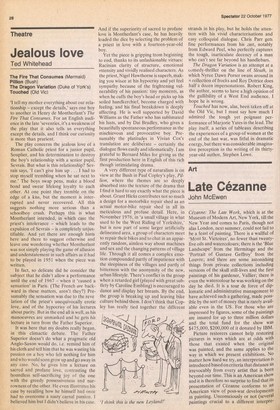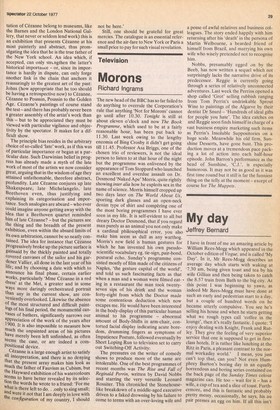Art
Late Cezanne
John McEvven
Cezanne: The Late Work, which is at the Museum of Modern Art, New York, till the New Year and comes to Paris, though not alas London, next summer, could not fail to be a feast of painting. There is a wailful of 'Mont St. Victoires', no fewer than twentyfive oils and watercolours; there is the 'Blue Landscape' from the Hermitage and the 'Portrait of Gustave Geffroy' from the Louvre; and there are some astonishing things from private collections including versions of the skull still-lives and the first paintings of his gardener, Varner; there is even the watercolour he was working on the day he died. It is a tour de force of diplomatic and administrative management to have achieved such a gathering, made possible by the sort of money that is rarely available even in the US. For those who are impressed by figures, some of the paintings are insured for up to three million dollars and the total fund for the show was $475,000, $200,000 of it donated by IBM.
Picture restorers cannot help restoring pictures in ways which are at odds with those that existed when the original was painted, and the same applies to the way in which we present exhibitions. No matter how hard we try, an interpretation is introduced based on criteria that distance Os irrevocably from every artist that is born beyond our time. This is an American show and it is therefore no surprise to find that its presentation of Cezanne conforms to an American view of post-war developments in painting. Unconsciously or not (several paintings crucial to a different interpre tation of azanne belong to museums, like the Barnes and the London National Gal lery, that never or seldom lend work) this is an exhibition that presents azanne at his most painterly and abstract, thus promulgating the idea that he is the true father of the New York school. An idea which, if accepted, can only strengthen the latter's historical importance — or, since its impor tance is hardly in dispute, can only forge another link in the chain that anchors it reassuringly to the greatest art of the past: Johns (how appropriate that he too should be having a retrospective now) to Cezanne, azanne to Poussin, Poussin to the Golden Age. Cezanne's paintings of course stand the test — and there has probably never been a greater assembly of the artist's work than this — but to be appreciated they must be viewed with particular vigilance and objectivity by the spectator. It makes for a difficult show.
The principle bias resides in the arbitrary choice of so-called 'late' work, as if this was of particular importance or began at a particular date. Such Darwinian belief in progress has already made a myth of the late work of most of the artists we now consider great, arguing that in the wisdom of age they attained unfathomable, therefore abstract, profundity. Late Cezanne conjures up late Shakespeare, late Michelangelo, late Beethoven even, thus justifying and explaining its categorisation and importance. Such analogies are absurd — who ever could imagine anyone getting away with the idea that a Beethoven quartet reminded him of late azanne? — but the pictures are the thing and the breadth of the present exhibition, even within the absurd limits of its own arbitration, cannot be so neatly contained. The idea for instance that Cezanne Progressively broke up the picture surface is gainsaid by the thickly painted and totally covered canvases of the sailor and his gardener Vallier, all done in the last year of his life; and by choosing a date with which to announce his final phase, certain earlier works, particularly 'Mme azanne in a red dress' at the Met, a greater and in some ways more daringly orchestrated portrait than any in the current show, are conveniently overlooked. Likewise the absence of the most structured and difficult paintings of his final period, the monumental canvases of bathers, significantly narrows our appreciation of the work of the years after 1900. It is also impossible to measure how much the unpainted areas of his pictures have merely been left unfinished, as often seems the case, or are indeed a compositional device.
Cezanne is a large enough artist to satisfy all interpretation, and there is no denying that the present array makes him look as much the father of Fauvism as Cubism, but the Hayward exhibition of his watercolours seems to have better revealed by its selection the words he wrote to a friend: 'For me what is there left to do. . .only to sing small; and were it not that I am deeply in love with the configuration of my country, 1 should not be here.'
Still, one should be grateful for great mercies. The catalogue is an essential reference and the air-fare to New York or Paris a small price to pay for such visual revelation.



































 Previous page
Previous page